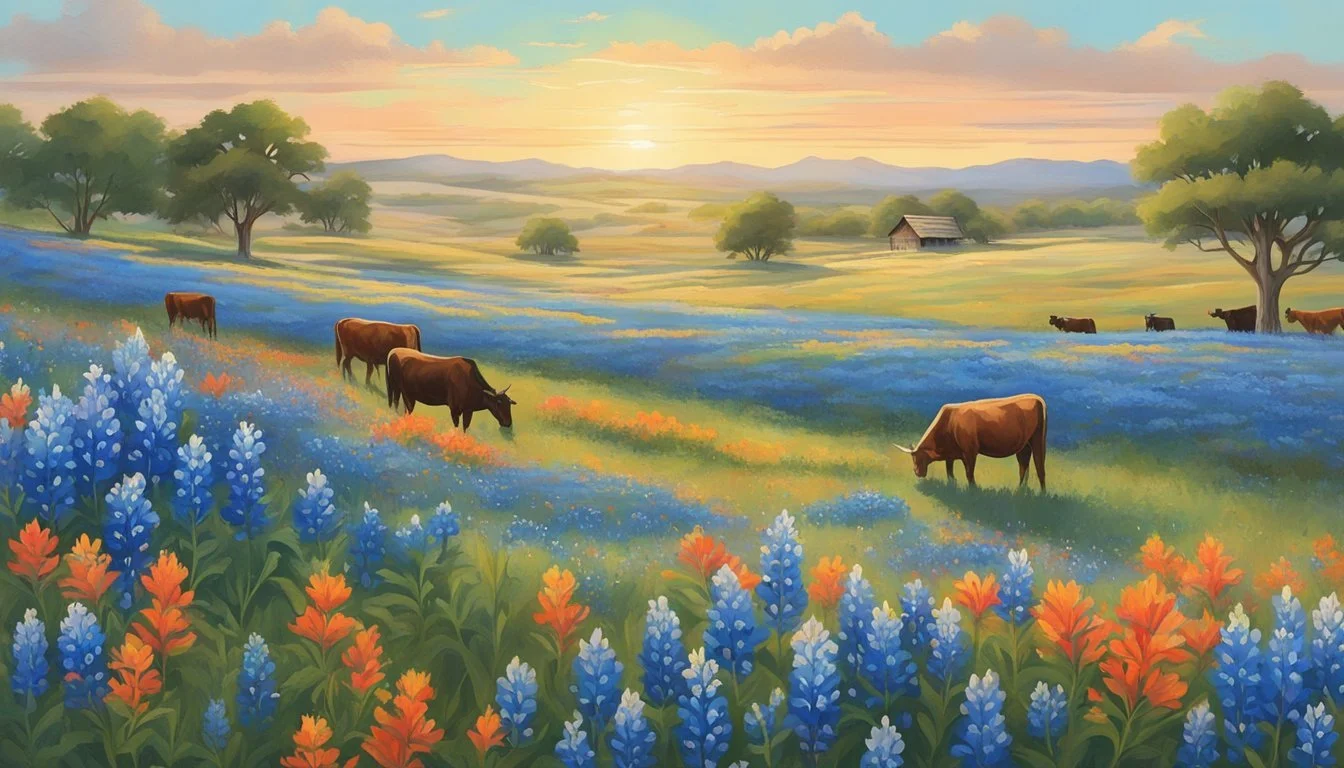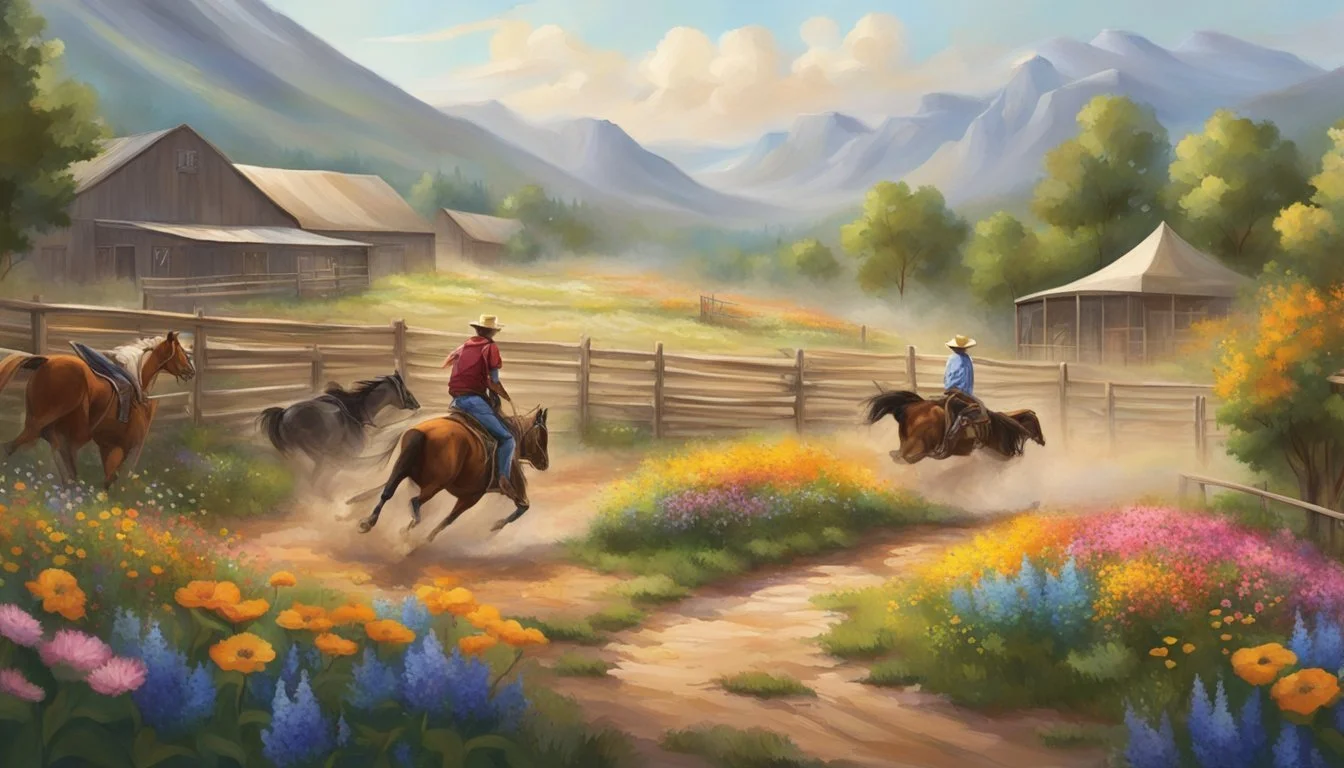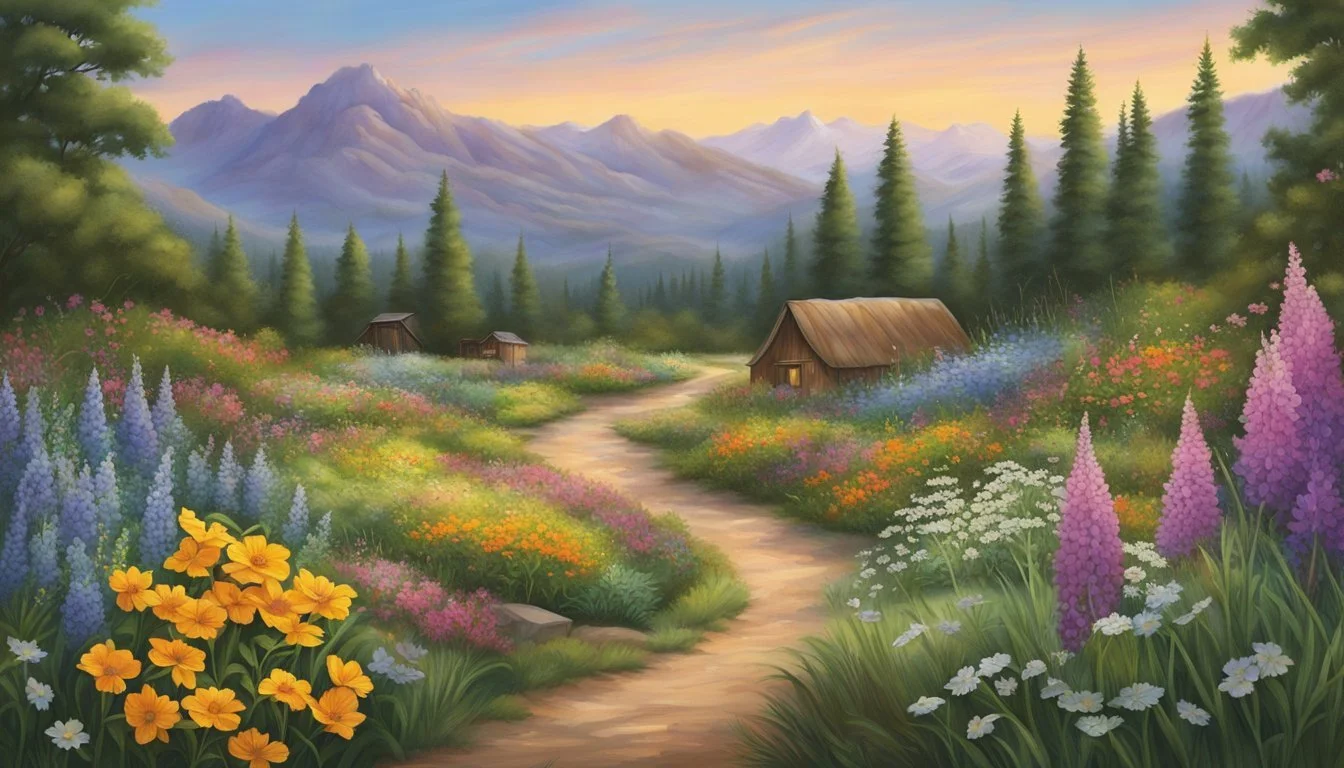The Texas Cowboy's Guide to the Wildflower Trails and Rodeo Gardens
Exploring the Lone Star State's Natural Wonders
The Texas cowboy is an enduring symbol of the American West, and the state's wildflower trails offer a stunning backdrop to the rich legacy of cowboy culture. Every spring, these trails come ablaze with vibrant colors, painting a picture as lively as the rodeos and festivals synonymous with Texas' heritage. Visitors to the Lone Star State can expect a visual feast on these rural paths, where the wild blooms set a stage for cowboy boots to tread among bluebonnets, Indian paintbrushes, and other native flora. Texas wildflower trails are not just a feast for the eyes; they are a homage to the state's natural beauty and the cowboy's harmonious relationship with the land.
Rodeo gardens, another distinctive feature of Texas, blend the raw excitement of the rodeo with the serene beauty of wildflowers. Cowboys and cowgirls from different backgrounds come together in these spaces to celebrate their shared history and to compete in events that showcase skills like riding, roping, and racing. The gardens echo the state's commitment to preserving its Western roots, nurturing both the flora and the traditional practices of the Texas cowboy. As wildflower season peaks, many rodeo venues embrace the blossoming landscape, incorporating it into their events or surrounding festivities.
Combining the love for rodeos with the appreciation of wildflowers, Texas offers a unique cultural experience. The wildflower trails and rodeo gardens reflect a blending of the state's natural splendor with its storied past. Whether one is saddling up for a competition or strolling through fields of wild blooms, the spirit of the Texas cowboy is alive and well, celebrating the old and new in a state where both nature and heritage are held in high regard.
History of the Texas Cowboy
The Texas cowboy embodies a rich heritage, originating from Spanish vaqueros and evolving through the cattle drive era. This transition in cowboy culture played a critical role in the development of the American West.
Origins and the Vaquero Influence
The roots of the Texas cowboy can be traced to the vaqueros of Mexico, skilled horsemen who managed cattle since the 1500s. When Texas was part of Mexico, these traditions were assimilated, forming the foundation of cowboy practices.
The Rise of Cattle Drives
Post-Civil War, Texas experienced an explosion in cattle drives, with the Chisholm Trail becoming one of the most significant routes. Drovers herded Longhorn cattle from ranches around San Antonio to markets in Kansas, driving the cowboy economy.
Impact of the Railroads
The emergence of railroads in cattle towns such as Abilene reshaped the cattle industry. Railroads enabled faster transportation and expanded markets, intensifying demand for cowboys and their cattle herding expertise.
The Goodnight-Loving Trail
Pioneered by Charles Goodnight and Oliver Loving, the Goodnight-Loving Trail was pivotal, extending from Texas through New Mexico to Colorado. It epitomized the cattle drive's extension, demanding strategic navigation to avoid Native American lands.
End of the Cowboy Era
The late 1800s saw the decline of the open range due to factors like barbed wire, ranch consolidation, and an agricultural shift. Yet, the spirit of cowboys endures, immortalized in Texas's culture and history.
Culture and Daily Life
In this exploration of Texas cowboy culture and daily life, the reader will discover the genuine practices of rodeo, the transition from herding to ranching, the essential tools, the culinary customs on the trail, and the historical interactions between cowboys and Native Americans.
The Reality of Rodeo Life
Rodeos are a sport deeply celebrated within Texas cowboy culture, highlighting the skills required for ranch life. Each aspect of rodeo, from bull riding to roping, stems from practical tasks real cowboys perform. Rodeo athletes commit to a grueling schedule, often traveling extensively, coping with the risk of injury, and living a nomadic life.
From Herding to Ranching
Originally, Texas cowboys spent much of their time herding cattle over vast open ranges. They carried out long cattle drives across the land, a practice that evolved into more stationary ranching. Modern ranchers oversee livestock within the parameters of their ranches, but the cowboy heritage of working the animals from horseback endures.
Cowboys' Tools of the Trade
Cowboys are synonymous with their iconic gear, continually honed for practicality:
Lariat: Used to catch livestock with precision.
Cowboy Hat: Designed to protect from the elements.
Boots and Spurs: Essential for horseback riding.
This equipment has become emblematic of the cowboy identity, each piece serving a functional purpose in daily ranch operations.
Cuisine on the Trail
The trail's cuisine was hearty and simple, a reflection of the need for sustenance during hard-working days. Cowboys often ate beans and bread prepared by the cook, who was an integral member of the cattle drive, operating from a chuck wagon. Meals were practical and sustaining, with beef often on the menu.
Cowboys and Native American Relations
Cowboys and Native Americans had complex relations, dictated by the expansion into what was considered Indian Territory. Interactions ranged from conflict over land and resources to exchanges of knowledge and cattle management techniques. This history is a tapestry of cooperation and confrontation that shaped the culture of the region.
Historic Trails and Rodeo Gardens
Texas is a land steeped in the legacy of cowboy culture, where the history of trail drives intertwines with the vibrancy of rodeos and the natural beauty of wildflower trails.
The Chisholm and Other Trails
The Chisholm Trail is one of the most significant cattle routes in North American history, guiding cowboys to drive herds from Texas ranches to Kansas railheads. Other historic Texas trails include the Opelousas and routes used by early vaqueros. These pathways are pivotal to the story of the Lone Star State, representing the grit and determination of the cowboys who navigated harsh terrains to move cattle northward.
Key Rodeo Gardens and Events
Fort Worth Stockyards is a hallmark of Texas, where rodeo gardens brighten up the historic site with native wildflowers. Annual events, such as the Houston Rodeo, add splendor to these gardens, coupling the excitement of rodeos with the picturesque Texas landscape. Here, one can witness the blend of floral beauty and cowboy athleticism.
Preservation of Wildflower Trails
Dotted across the state, wildflower trails are testament to Texans' commitment to preserving their natural heritage. Initiatives such as the Lady Bird Johnson Wildflower Center actively work to maintain these living tapestries. Guided by efforts to protect these areas, the wildflowers create scenic routes for both tourists and locals to enjoy the state's multifaceted beauty.
Cowboy Attractions and Museums
Texans honor their cowboy heritage through various attractions and museums. The Cattle Raisers Museum and King Ranch stand out as institutions showcasing this rich history. They exhibit the legacy of trail drives, while places like the Chisholm Trail Outdoor Museum offer an immersive peek into the past, highlighting the herding routes that shaped trade and transport across Texas.
Wildlife and the Environment
In the varied landscapes of West Texas, cowboys navigate a region that is diverse in both wildlife and environmental conditions, influencing ranch activities and the conservation practices essential to sustaining the ecosystem.
Flora and Fauna of West Texas
West Texas is known for its rich biodiversity, particularly the flora and fauna that are as rugged and enduring as the cowboys themselves. Along the wildflower trails, one can spot the vibrant bluebonnets and Indian paintbrushes that paint the countryside each spring. Wildseed Farms near Fredericksburg even celebrates these flowers with an annual festival. Amidst the flora, fauna like white-tailed deer, coyotes, and numerous bird species thrive, coexisting with the livestock, longhorn cattle, and other animals that roam the rangelands. Hunting, tightly regulated to maintain balance, is a part of the local culture and economy.
Common Wildflowers:
Bluebonnet (Lupinus texensis)
Indian Paintbrush (Castilleja indivisa)
Notable Wildlife:
White-tailed Deer (Odocoileus virginianus)
Coyote (Canis latrans)
Weather Patterns and Cowboy Life
The vast regions of West Texas, running from the Brazos River to the Rio Grande, are subjected to a kaleidoscope of weather patterns. Cowboys in areas like Weatherford wear many hats—not only due to the ever-changing weather but also as a result of the demands imposed by the environment on ranch operations. From searing heat to sudden thunderstorms, weather has a dramatic impact on the land and the well-being of the herds. Livestock management and daily tasks are not only dictated by the seasons but also by real-time weather conditions, necessitating a versatile and resilient approach to cowboy life.
Weather Influence on Ranch Activities:
Planning grazing to prevent overuse during drought
Monitoring herds for signs of weather stress
Conservation of the Rangelands
Conservation is a cornerstone of sustainability in West Texas. The rangelands, which provide habitat for wildlife and grazing areas for ranches, must be managed with care to prevent overuse and promote biodiversity. Ranchers often work in tandem with conservationists to ensure that practices like rotational grazing maintain soil health and prevent erosion along vital waterways such as the Red River. By balancing the needs of the environment with the demands of livestock and ranch operations, they work to preserve the ecology of their ranges for future generations.
Conservation Practices:
Rotational Grazing: Dividing rangelands into sections to allow for rest and regrowth
Habitat Restoration: Replanting native grasses and plants to prevent erosion and support wildlife
The Legacy of the Texas Cowboy
The Texas cowboy represents an indelible symbol of frontier spirit and traditions that have shaped not just the state of Texas but also the broader North American culture.
Influence on North American Culture
The Texas cowboy is a foundational part of North American culture, with its roots in the diverse practices of Indigenous peoples, Mexican vaqueros, and European settlers. This figure has come to embody values such as rugged individualism and steadfast bravery. Cowboy hats and cowboy boots, initially practical gear for ranch work, have evolved into iconic elements of fashion across various markets.
Rodeos and the Cowboy Spirit
Rodeos reflect the competitive and adventurous side of the cowboy spirit, transforming cattle wrangling skills into a celebrated sport. What began as informal competitions among cowboys has grown into a widespread, organized event showcasing horsemanship and the traditions of the Texas cowboy.
Key Rodeo Events:
Bull riding
Barrel racing
Steer wrestling
Team roping
Literature and Cinema
Texas cowboys have been immortalized in books and films, often in a romanticized manner, highlighting their adventurous lifestyle. Literature and cinema have played a significant role in perpetuating the cowboy legacy, from classic Westerns to contemporary stories that challenge and broaden the image of the cowboy.
Notable Texan Cowboy Representations:
Lonesome Dove (Novel and TV adaptation)
The Searchers (Film)
No Country for Old Men (Film and Novel)
Texas Cowboy in Modern Times
In contemporary times, the image of the Texas cowboy has evolved while maintaining its cultural significance. Today's cowboys reflect a diverse background, including the recognition of African American cowboys who played a vital role yet were historically overlooked. Rodeos remain a popular pastime in Texas, and cowboy culture continues to thrive, even in modern markets and media.
Appendix
This appendix serves as a resource for readers seeking to enhance their understanding of cowboy culture in relation to Texas wildflower trails and rodeo gardens. It includes a glossary, profiles on notable individuals involved in cowboy history, an overview of historic trails and sites, and a curated list of further readings and resources.
Glossary of Terms
Cowboy Culture: Refers to the customs, traditions, and way of life of cowboys, particularly associated with the American West.
Drovers: Cowboys or workers who move livestock over long distances.
Remuda: A herd of horses from which cowboys select their mounts.
Trail Boss: The leader in charge of a cattle drive.
Horse Wrangler: A cowboy responsible for the care and management of the remuda.
Mavericks: Unbranded cattle, especially those considered as lost or stray.
Stampede: A sudden, panicked rush of livestock, typically cattle.
Notable Personalities
Jesse Chisholm: A trader of Cherokee descent who established the Chisholm Trail, a major cattle route from Texas to Kansas.
Jack Bailey: Known as the "Cattle King of Texas," influential in cattle driving days.
Charles Goodnight: Co-founder of the Goodnight-Loving Trail, an important cattle drive route.
Oliver Loving: A partner with Charles Goodnight, who died on the trail that now bears his name.
David Dary: An author known for his contributions to documenting cowboy culture.
Historic Sites and Routes
Chisholm Trail: Originating in San Antonio, it was a prominent cattle drive route to the railroads in Kansas.
Goodnight-Loving Trail: Extended from Texas to Colorado and Wyoming, used for driving cattle during the 19th century.
San Antonio: Starting point of many cattle drives in Texas history.
XIT Ranch: A historic livestock ranch that was one of the largest in the world during the late 1800s.
Further Readings and Resources
Books:
"The Cowboys" by David Dary - Insight into cowboy culture and history.
"Cowboys of the Americas" by Richard Slatta - A comparative study of cowboys across different countries.
Artifacts:
Visit the National Cowboy & Western Heritage Museum for historical cowboy artifacts.
Online Resources:
Texas State Historical Association website – Offers articles on cowboy history and cattle drives.




